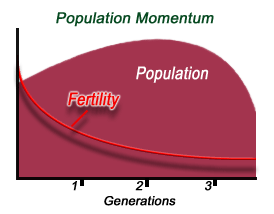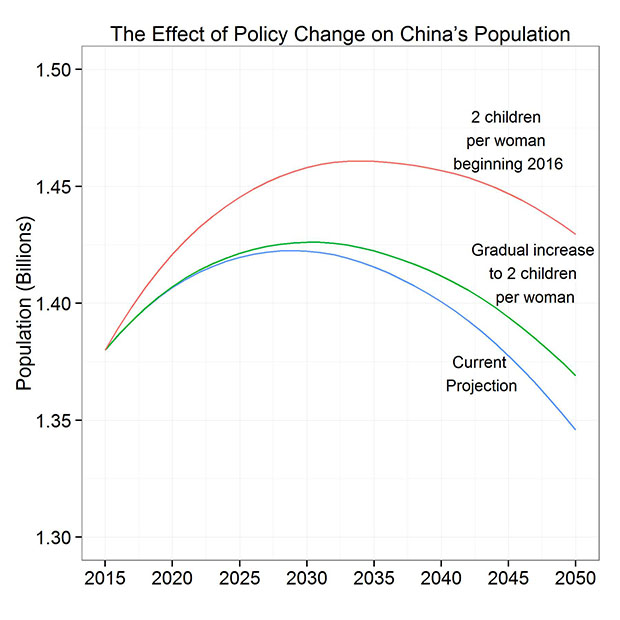China's two-child policy fails demographic reality - population will continue to grow
Faced with unending and unsustainable population growth, China implemented its one-child policy in 1978. It successfully achieved one of the fastest fertility declines in history.1
Misguided American leaders took issue with this rational and necessary population policy. President Jimmy Carter tried in 1979 to get China to allow more people to emigrate. At a joint meeting, Chinese leader Deng Xiaoping leaned forward, spreading his arms, and said to Carter, "Fine. How many do you want? Ten million?"2
Recently, China changed its policy. The state news agency, Xinhua, stated that “The change of policy is intended to balance population development and address the challenge of an ageing population.” Since 2013, eligible couples have been allowed to have a second baby if either parent is an only child.3
A study by the University of Oxford and Xi’an Jiaotong University, published in the journal Studies in Family Planning presents additional information. The study presents UN data that show China’s population aged 65 and above will nearly triple from 9% in 2010 (or 114 million) to 24% (331 million) by 2050. At the same time, the working population aged 20-34 is projected to shrink from 25% (333 million) of the population in 2010 to 16% (228 million) by 2050. The study notes that even though the country has had below replacement fertility for more than 20 years, total population has still grown by around 200 million over the same period and is forecast to continue growing for another 15 years.4
 The reason for continued population growth when fertility is at or below replacement level is population momentum.5 Population momentum is the tendency for population to continue to grow even after replacement-level fertility (2.1 children per woman) has been achieved. It is caused by a relatively high concentration of people in their childbearing years - that is, by a population that is age-biased toward youth.
The reason for continued population growth when fertility is at or below replacement level is population momentum.5 Population momentum is the tendency for population to continue to grow even after replacement-level fertility (2.1 children per woman) has been achieved. It is caused by a relatively high concentration of people in their childbearing years - that is, by a population that is age-biased toward youth.
It takes a period of time equal to the average life expectancy (approximately three generations or 73 years in the U.S.) for a reduction in fertility to be manifested as a change in actual population numbers. This graph shows how population keeps growing long after fertility is reduced.
It is therefore crucial that steps to reduce fertility are taken sooner rather than later. China did that with its one-child policy. Indeed, they were successful, but not as successful as if the policy had been implemented sooner.
China is the most populated nation
With 1.4 billion people contained within a land mass approximately the size of the United States, China is the most populated nation. At an overpopulated 1.3 billion, India is second. At 321 million, the United States is the third most overpopulated country on the planet.6 Unfortunately, mass immigration is driving U.S. population to double this century. It's as if we're in a race to join the overpopulated one billion club.
The following graph from Population Reference Bureau shows China's projected population under three scenarios:1

If China had maintained its current one-child policy, population would have increased to 1.43 billion in 2030 (due to population momentum) and then would begin to decline. It would take until about 2045 for the population to decline back to the present level.
The two-child high fertility scenario shows population increasing to 1.46 billion in 2035. By the year 2050, population would still be significantly higher than today's population. The gradual increase two-child scenario shows population increasing to 1.43 billion by 2030. It would decline to slightly less than today's population by the year 2050.
PRB states that "The difference in 2050 between the current projection and gradual increase scenario is 23 million people, less than 2 percent higher than PRB's projection under the one-child policy."1 That's equivalent to 7 percent of the U.S. population.
Even so, PRB projects that there will be fewer working-age people compared to nonworking-age people in 2050 compared to 2015. Thus, in order to bolster future economic productivity based on the sheer numbers of workers, China is sacrificing long-term sustainability for short-term economic gain.
Fertility is driving China's population growth, while mass immigration is driving America's population growth. Yet in both cases, the myopic objective of ever-increasing economic productivity is the fundamental reason why sustainability and population stabilization have not been achieved.
References
1. China Abandons One-Child Policy, Population Reference Bureau, October, 2015.
2. Responding to George Will's 'Welcome to America' Proposal, Jerry Kammer, Center for Immigration Studies, July 28, 2014.
3. Why scrapping the one-child policy will do little to change China’s population, The Conversation, October 29, 2015.
4. Why reform of China’s one-child policy has had little effect in boosting fertility levels, University of Oxford.
5. Fertility and Population Momentum, CAIRCO.
6. World Population Data Sheet interactive dashboard, Population Reference Bureau, 2014-2015.
